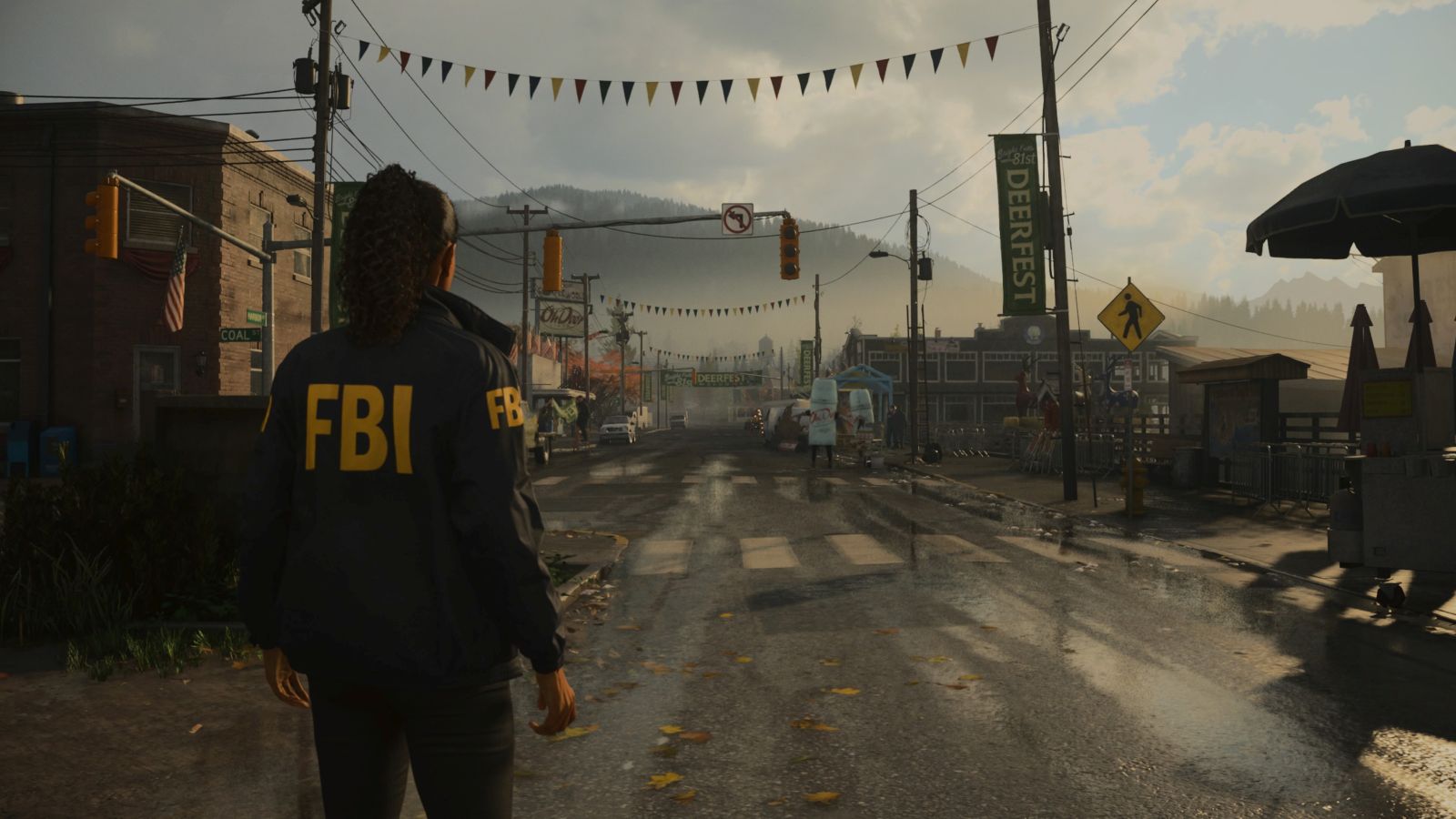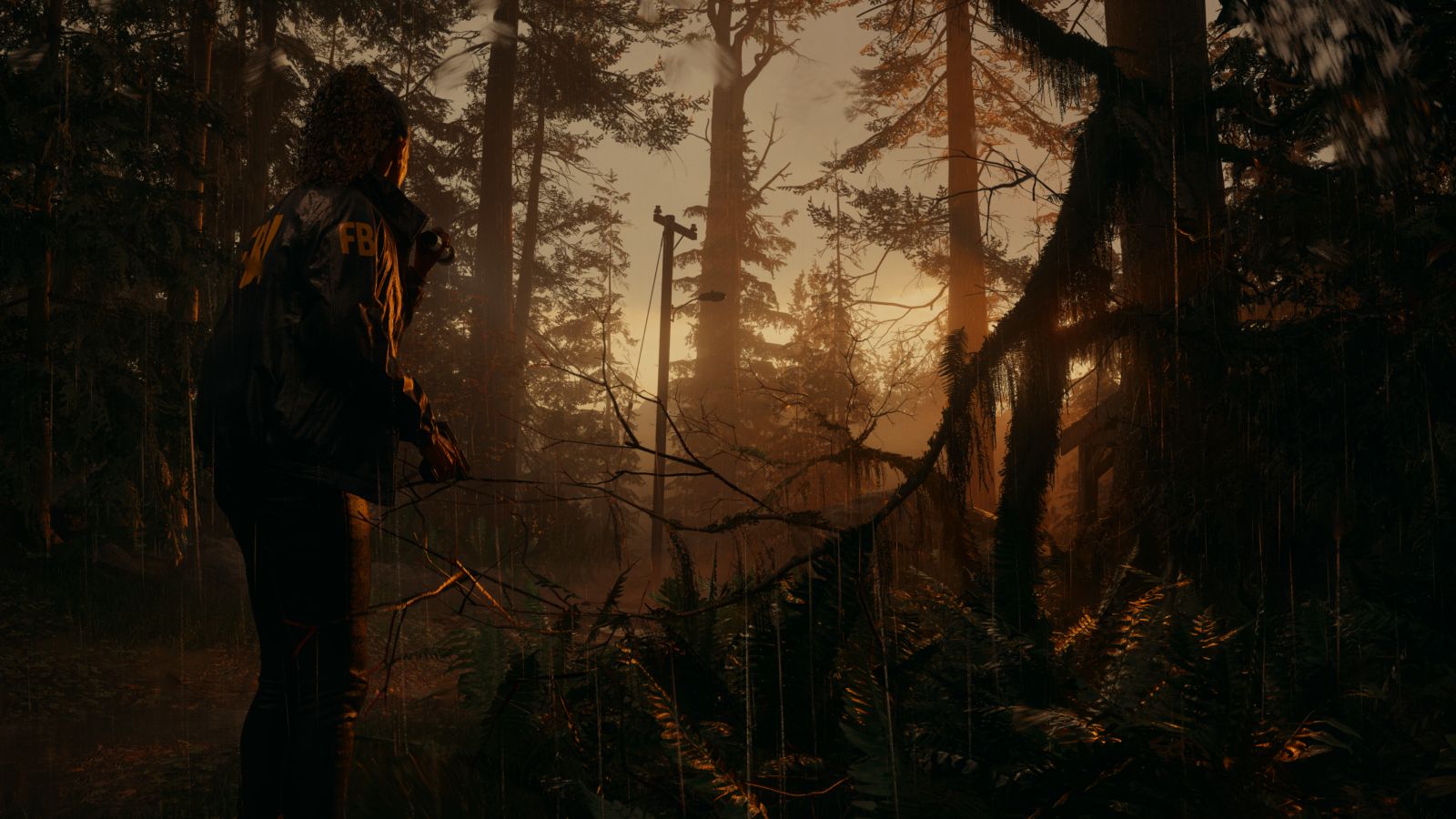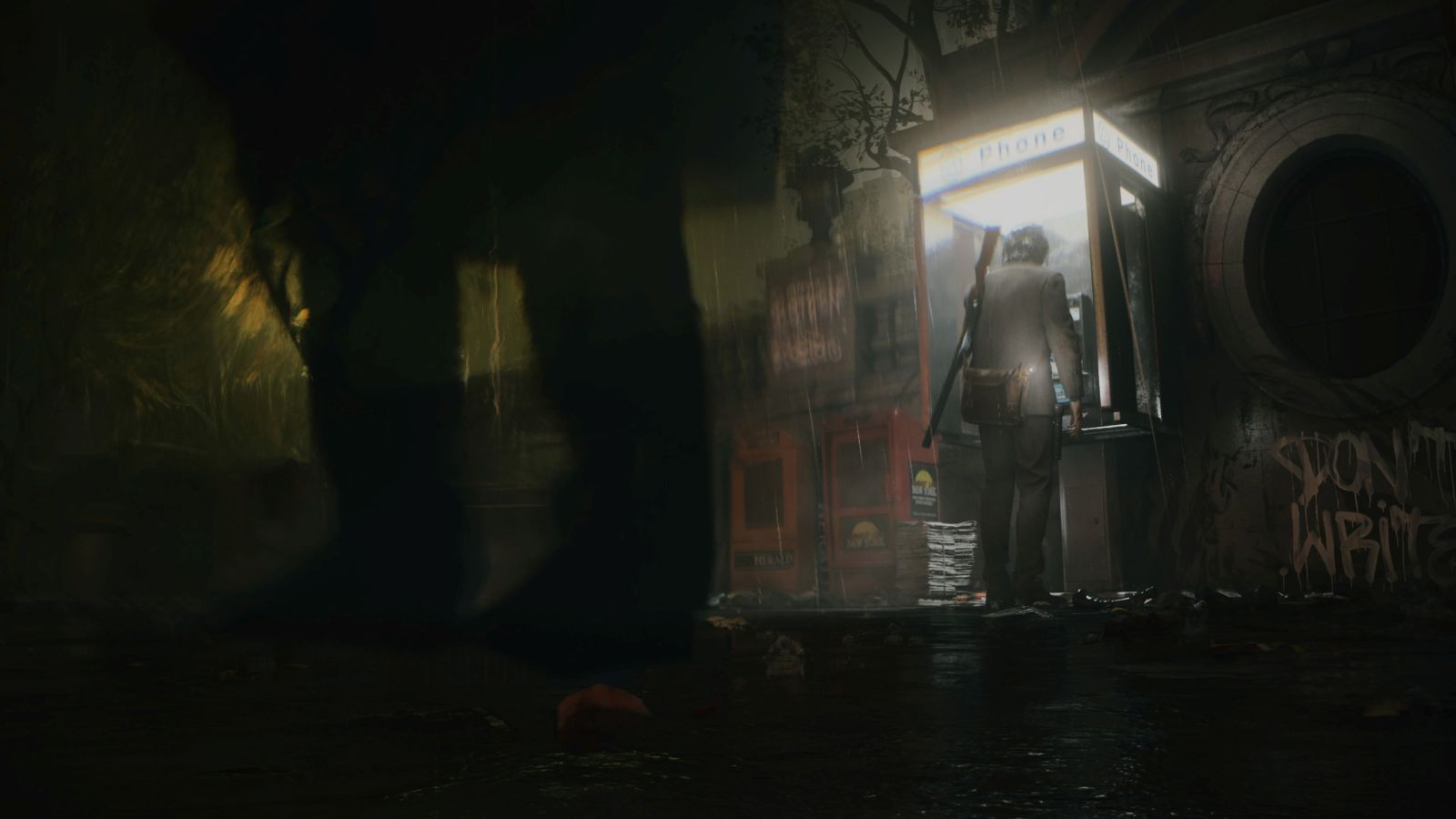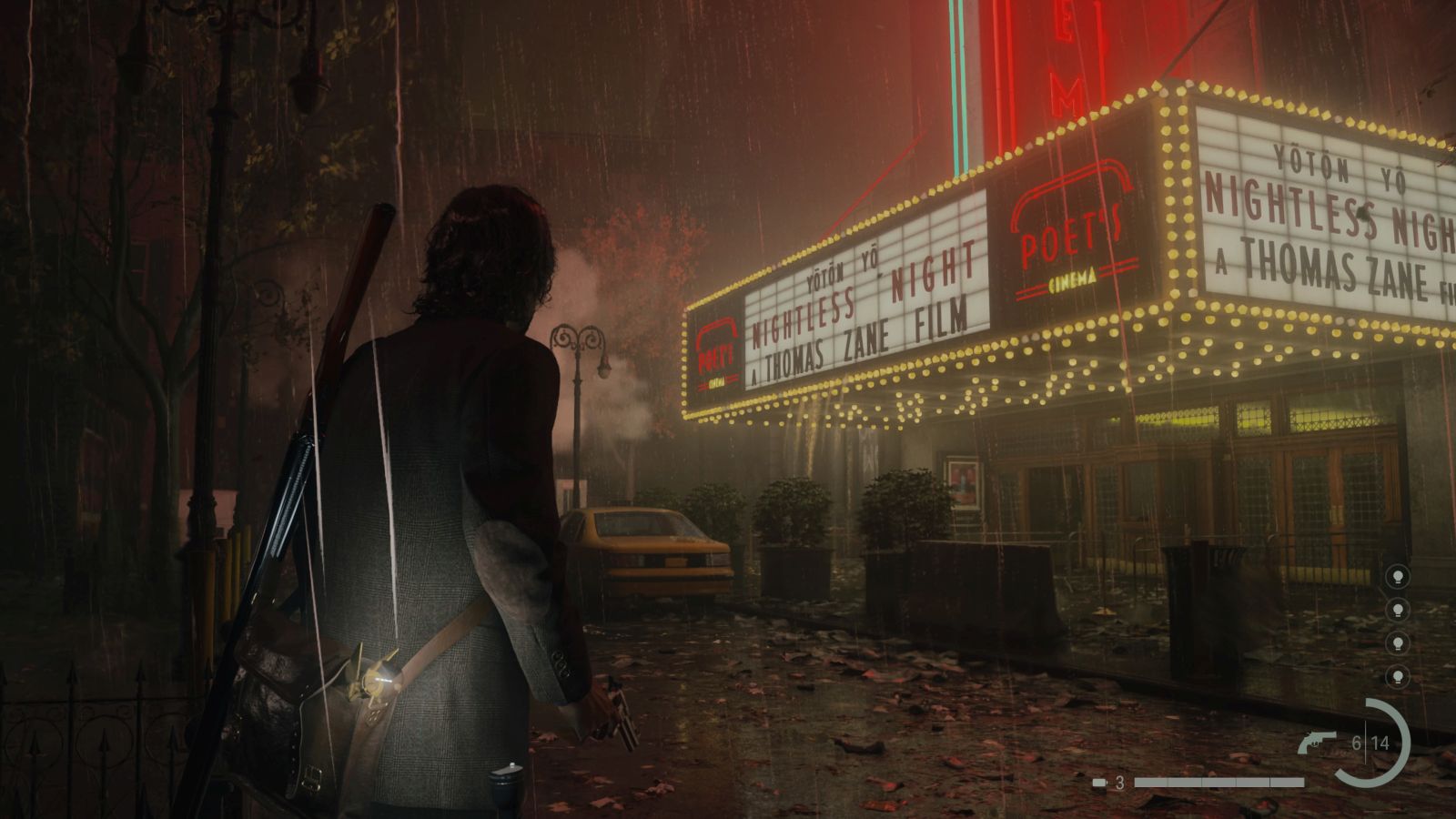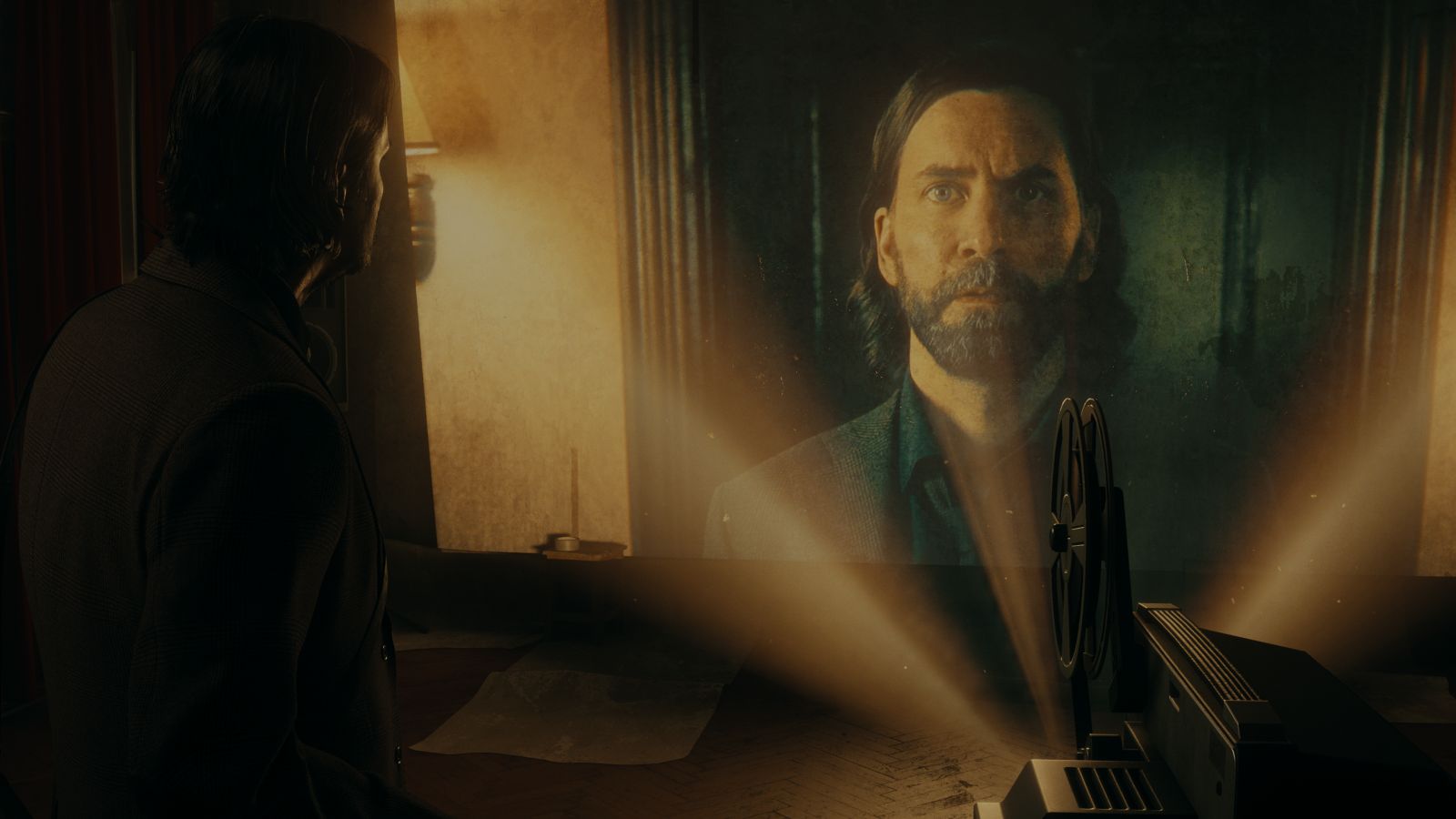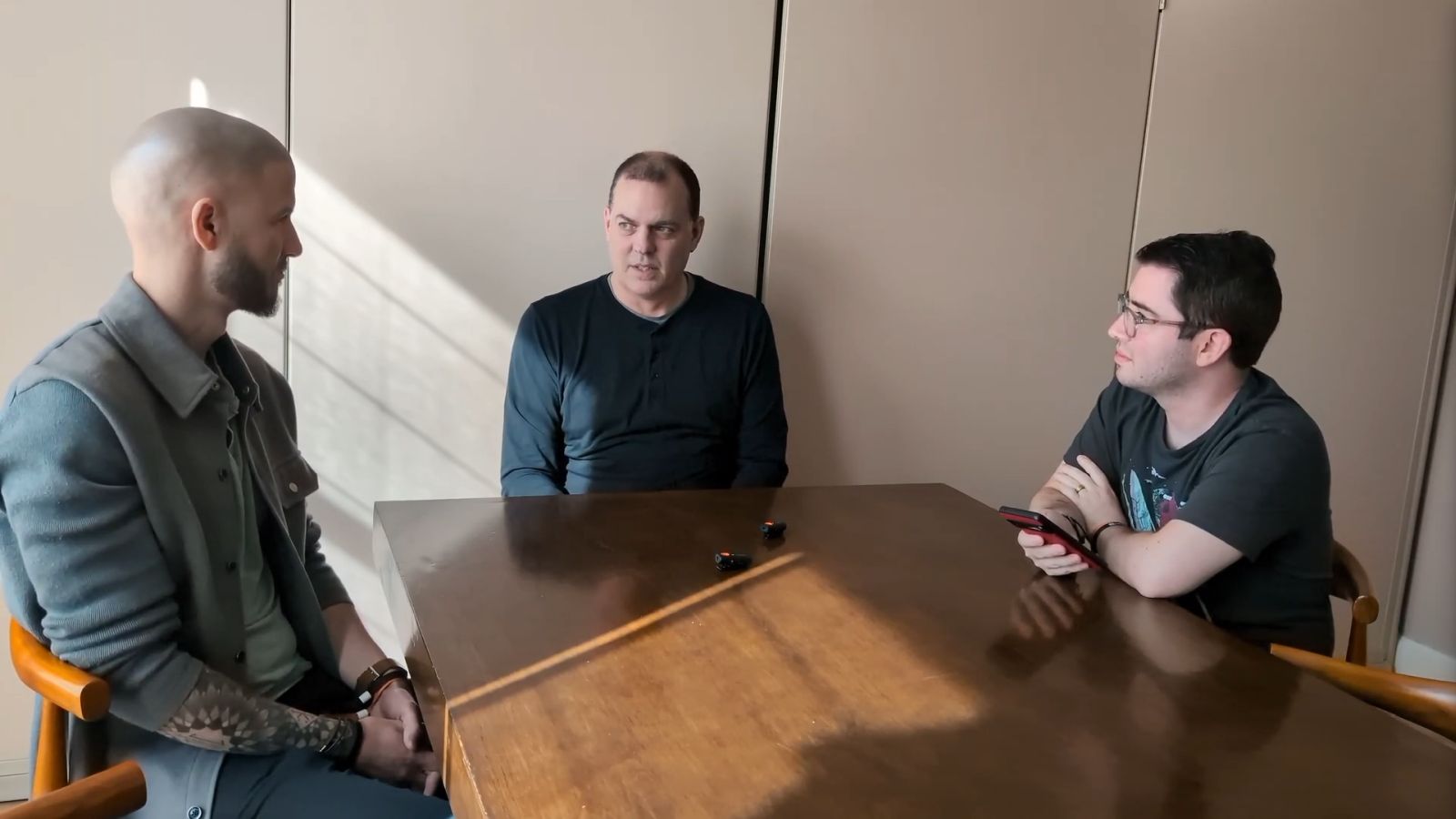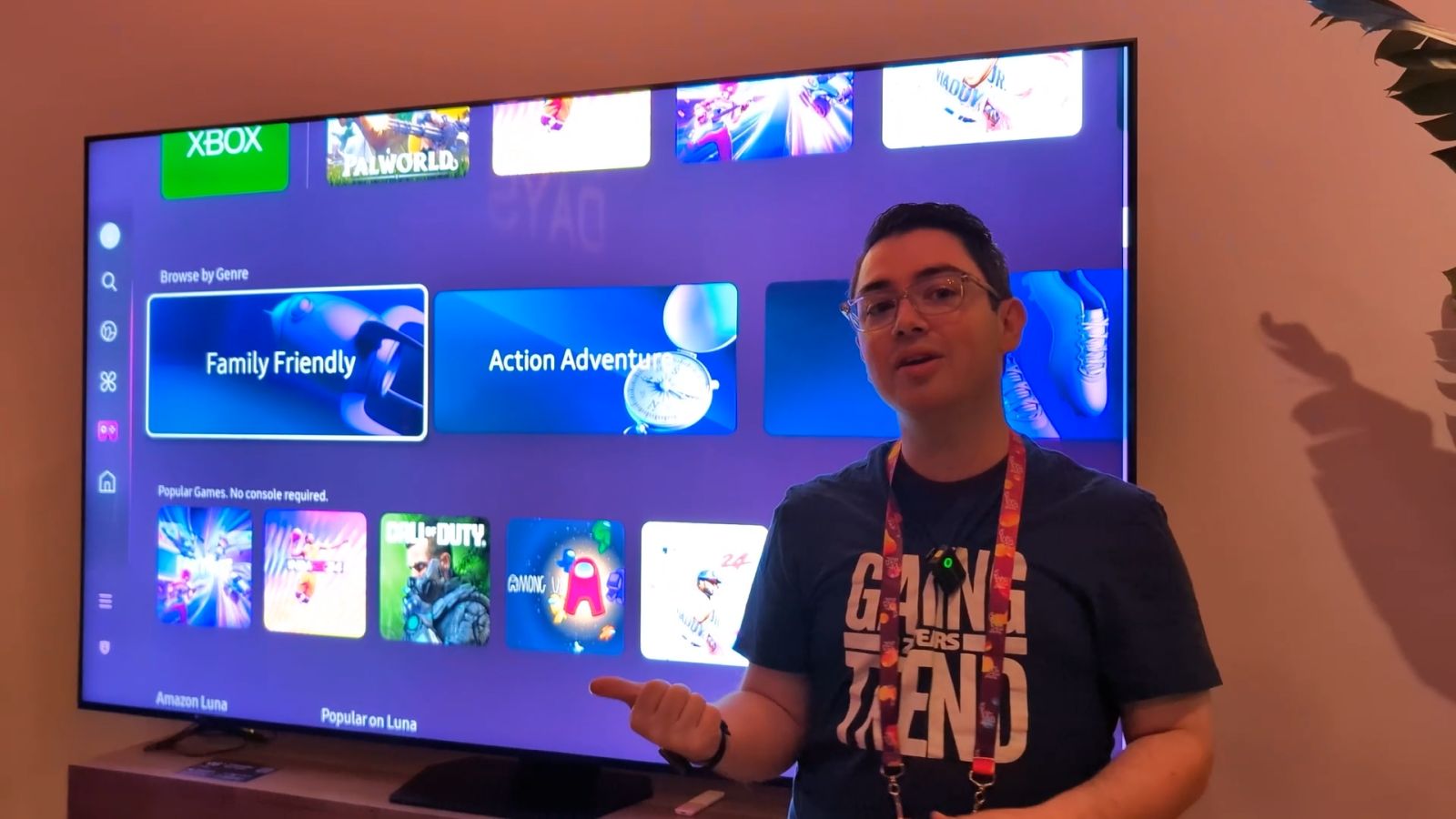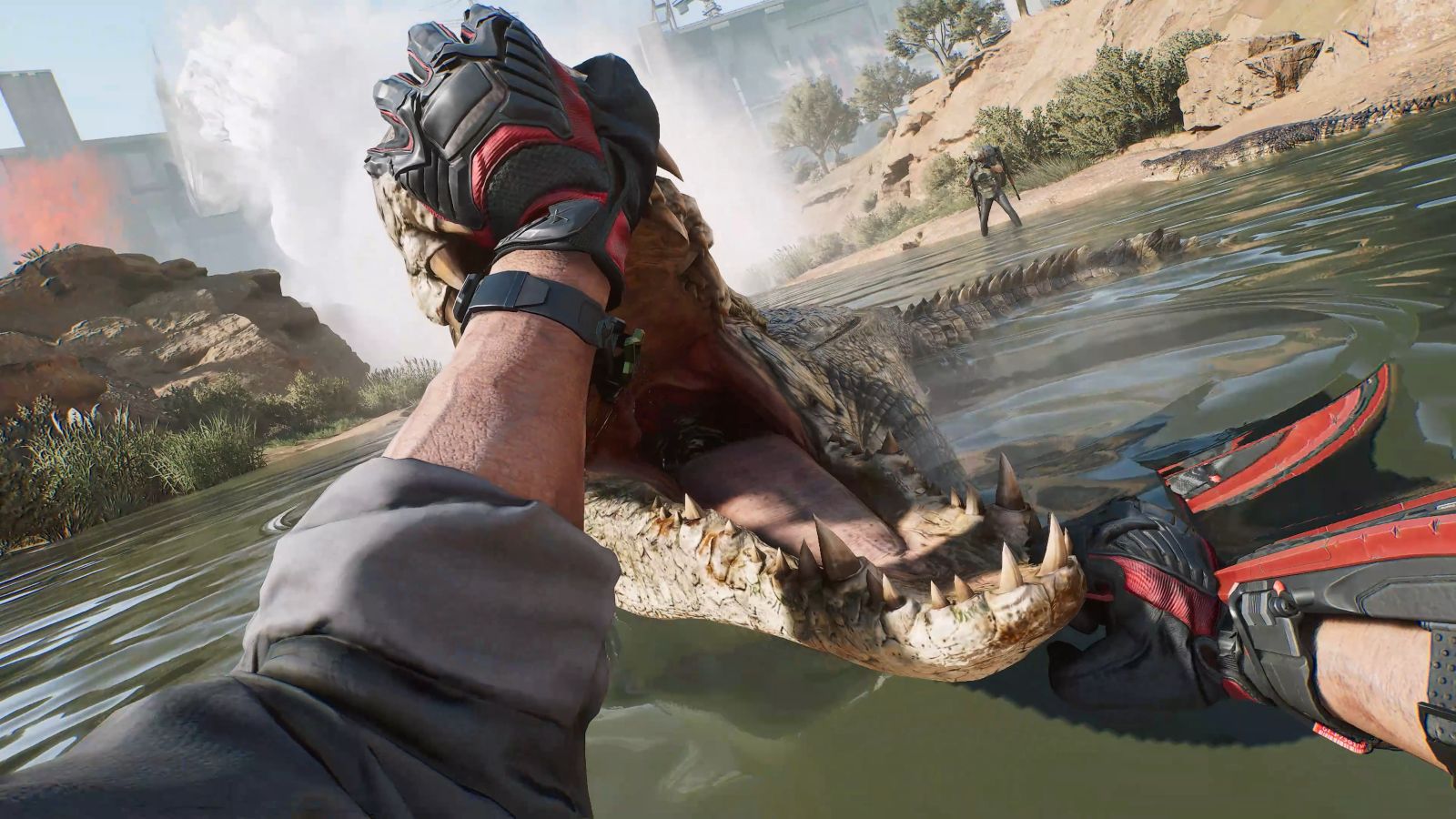Alan Wake is trapped. Not just in The Dark Place, but in our world as well. It’s taken thirteen years for him to resurface; eleven if you count American Nightmare. Some characters would be lost to memory, but Alan has been languishing away at a typewriter, reaching out from his prison. Thankfully, Epic Games got a manuscript page and signed the dotted line, but there’s a remaining question after this long: Is Alan Wake still alive? The answer to that question is a resounding yes.
Alan Wake 2 begins in the most visceral introduction of any of Remedy’s games. You rise from Cauldron Lake as a nude character, and proceed forward, only to be stopped halfway up the shore, tied to a table, and have your heart ripped out. This ritual killing is horrifying, but exemplifies the energy Remedy is looking to immediately build. The good news is that the FBI is already heading into Bright Falls, called upon due to similar killings happening recently. There’s an odd connection here, however, with all of them occurring with victims that have been missing since 2010; the same year Alan Wake dove into the lake.
This is where the story truly starts, with new heroine, FBI Agent Saga Anderson, driving down the wet, mountain roads of Washington. With her is FBI Agent Alex Casey (who is modeled after Sam Lake, creative director at Remedy, and who also crushes it alongside voice actor James McCaffery), who has the same name as the main character detective from Alan Wake’s books. As is with the original, you really have no clue what’s going on, and that permeates much of the story. I’m a huge fan of movies like Inception and The Prestige, so this fits well. That said, you have to bring everything together at the end, and just like the aforementioned movies, Remedy brings it.
The story Alan Wake 2 tells is intricate, and this is accomplished by having two main characters along with two sides of the story. Saga is on “our” realities side, and Alan is in The Dark Place, trying to escape. This duality isn’t easy to achieve, and while it can be occasionally convoluted, Remedy tells it well. At a certain point early on you have the choice to swap between Saga and Alan. While you could go with one in particular, I suggest jumping between them at each chapter’s end. There are several interactions that benefit from your remembrance of certain dialogue, so the flow is assisted this way.
If this lake is an ocean, you don’t see many spaces where salt and freshwater meet. That is to say, everything is interconnected and spliced together in a manner that makes sense. You still have plenty of set up; and even some moments where you’ll question what Remedy is doing, but the payoff is well worth it. Watching Saga make these discoveries, seeing Alan put together the things on his side; it all comes together in the endgame.
Alan Wake 2 — Launch Trailer
I put about sixteen hours into Alan Wake 2, and the final parts (which are linear) take about two or so hours of that. Everything prior has brought you to this moment organically, with the culminations of plot points feeling earned. Honestly, you’ll be mind-blown at quite a few of them, with several “Oh my, that’s what they were building to?!” exclamations, whether literally or mentally. It’s quite the accomplishment by Remedy, somehow giving fans a worthy successor to a cult classic over a decade in the making.
As I said in our preview, Saga’s section leans more towards the original Alan Wake in both look and combat, but it’s different in several aspects. Saga’s FBI status leads her to be a much more confident player in this game, so her approach to most situations isn’t as panicky as our favorite writer’s were thirteen years ago. Conversing with locals also leads you into new paths, a new direction that adds worth to the dialogue. Melanie Liburd does the part justice with her vocal and physical performance, proving a worthy addition to the cast. Oh, and the eventual revelations of why she is here? I absolutely love them.
Saga’s key ability is the Mind Place. This is one of the more important areas in the game, both in design and in function. The Mind Place is a sort of pause menu (without the pause part), but in the form of a room you navigate with Saga. She will profile subjects, put together clues on the caseboard, and even upgrade her weaponry here. It’s important to check back as you go along, because while the game does a good job of leading you without it, some discoveries necessitate your presence in the Mind Place. Also, without spoiling anything, there is a huge reveal in regards to this location that turns your expectations on their head.
Combat is refined, but not the focus of Alan Wake 2. Saga will employ many familiar items in Alan Wake 2, like a pistol, shotgun, flashlight, and other light-producing items, like flashbangs or flares. Unlike the original, healing is done with health items. In the sequel, you’ll find painkillers, trauma pads, and first aid kits, with these necessary to your staying alive. This, combined with needing batteries to power the total number of charges on your flashlight make this resemble a survival horror game as opposed to the thriller before it.
Enemies (The Taken) still require you to burn the darkness off of them, and I still think it’s one of the coolest mechanics designed. There’s a satisfying screech as you melt away The Dark Presence with your light, and an equally satisfying audio cue when it’s expelled. You’ll also see the damage you’re dealing, with a new system in place for wounds. Given the survival horror nature of Alan Wake 2, make your flashlight charges count along with your bullets (and don’t forget to dodge); the second you think you’re well stocked, something comes up and you’re suddenly up a creek without a paddle.
None of the Taken felt too spongy, and the rate of them popping up also led to my not minding the lack of variants. It doesn’t feel necessary to go too heavy on introducing a bunch of new enemy types when you aren’t encountering them at a blistering pace. Instead, it feels well thought out. There are also several “boss” encounters that are just tremendous, with great characters surrounded by phenomenal set pieces.
Atmosphere is one of the most important things in a horror game, and Alan Wake 2 has that in spades. Walking through each place on Saga’s side is both enjoyable and frightening. For example, going past the Oh Deer Diner fills me with nostalgia, but entering the Valhalla Nursing Home’s dark Wellness Center had me uneasy as all get out. Similarly, exploring Cauldron Lake’s surrounding area is fine… in the daytime. Once night fell, I was ready to get back to Casey and the car, jetting through foliage and avoiding every muttering Taken I could. Creeping through the shrubbery or down a hallway while shining your flashlight around each corner puts you on edge. Creating tension is an art form, one that Remedy has mastered. In parallel to the enemies, there aren’t a ton of different places to explore, but all feel varied enough to be satisfying.
Not only that, they’re absolutely stunning, with crisp visual fidelity just waiting to be surveyed. The mountainous and rocky forests of the Northwest look fantastic, flowing over with flora and fauna. There are several missions that take place in similarly magnificent locations, like the sputtering neon-covered Coffee World, or the Valhalla Nursing Home Wellness Center. The lighting is especially good as well, even if the console versions don’t feature fancy ray tracing that I’ve thought about since hearing the terminology and applying that to the iconic Alan Wake flashlight.
This is followed up in the audio design, which especially in combat is simply spectacular. The crack of Saga’s service pistol, the ferocity of Alan’s revolver, the roaring blast of the shotgun, and the punch of the hunting rifle are felt in your chest. There’s an impact to what you’re doing, and it’s immaculately conveyed. Combat may not be what this game is built around, but using them is quite delectable. All of that, along with the wail of the soundtrack lingering in the background and the very obvious muttering of an enemy or crackling of forest noise leave you unsettled.
Progressing through Saga’s story means traveling through Bright Falls and a few other locations. This is dissimilar to the original, where you simply moved from one end of the level to the other with very little in between. Saga can immediately head to the mission at hand, or decide to look around these open levels to find things of use. There isn’t a ton of side stuff, and nearly all is prevalent to your upgrades (like Charms that give perk-like boosts) or items that might come in handy later. But, there are a few “off the beaten path” moments that bring new revelations through readable, audible, or viewable lore, like a file on a murder or a commercial on a TV.
Many might worry that Alan doesn’t even get the spotlight in his own story, but they shouldn’t. Alan Wake gets center stage in many ways in his sequel, and it’s never wasted. Ilkka Villi and Matthew Porretta once again do an outstanding job portraying the writer, who is sifting through the information at hand but can’t put a finger on how to get out of this nightmare. There’s a feeling of being overwhelmed as you play as Alan, and it largely stays that way throughout the game.
Alan’s sections are focused on his writing abilities. His greatest talent is changing reality through his words, and that continues to come into play here. When The Dark Place finally reveals its newest locations to you, Alan will go to solve a mystery there in hopes of rewriting part of the story; not simply to change The Dark Place, but to gain a way out.
Once there, you can revise each area with two tools, the Angel Lamp and amending the plot. The Angel Lamp allows you to remove light from one place and move it to another, and the removal or injection transforms each space, allowing you to continue on your way. As for amending the plot, like Saga, Alan has a Mind Place. Instead of profiling and using a case board, you will be observing and using that to change the plot in front of you. For instance, I made it to the Ballroom, one of the scenes that has been constructed by The Dark Place. At the moment, the scene’s plot element is set to being a “Pre-Show Ritual”, so nothing is happening at all here at the moment.
Swapping this plot element with a new card called “Haunted” suddenly changes everything, with the stage now unblocked, chairs strewn around the room, and a new Echo (an in-game scene you trigger) available. By the way, these also push the story forward, unlocking new plot elements. I’m amazed at the technical marvel in front of me, because it’s like multiple instances of the game running over the top of another. After the scene played out, I was pushed into a fight with dark shadows, with some burned away completely by my flashlight, and others needing a few bullets. The combat may be the same, but the approach takes on a new form here.
The journey Alan takes through The Dark Place is certainly memorable, and largely because of its tone. I’ve always been impressed with how Remedy crafts their narrative tone, and here it’s on a level I’d almost label utterly ridiculous. There is a swing at times that leaves you questioning what the heck is going on, but it somehow fits. They keep getting away with it, and I’m completely fine with that.
A big part of that is Remedy’s take on horror. Yes, they are pushing things further than the PG-13 psychological thriller Alan Wake was, but it isn’t ever gruesome for the sake of being so. It’s intelligent in its design, pressing the right buttons to raise your apprehension in both Bright Falls and The Dark Place. As someone who isn’t a big fan of horror games, there are only two sections (one from each playable side) I’d label as terrifying, and they’re still done correctly in not taking advantage of me. It’s more as if they prey on my trepidation instead of looking for a cheap scare.
Setting this up is handled expertly by Remedy through both visuals and atmosphere. We’ve already discussed Bright Falls and its ambience, and this faux New York has its own gripping aura. The Dark Place is… well, dark, but it’s not enough to simply be dark, it embodies the dark. You feel the black of night surrounding Alan, washing over even the bright neon signs of the city blocks. There’s a dread, an unnatural anxiety to this place, driven home by the dusky silhouettes populating the streets and locations you visit. These may or may not attack you as well, leading to more uneasiness.
I do want to address the government agency in the room- The Federal Bureau of Control. Control is one of my favorite games, and the DLC crossover was more than confirmed in Alan Wake 2. I won’t spoil any details, but with a huge presence right away in this sequel along with planned DLC that will take us to an FBC facility on Cauldron Lake the connection has been cemented and will most likely play a big part in Control 2. It’s done as well as the dual narrative; it belongs here and is deftly integrated. Also, Janina Gavankar is awesome as FBC Agent Kiran Estevez.
Music has always been a pivotal part of Remedy’s games, with the recent standout example of the Ashtray Maze in Control. There’s not necessarily a level as bombastic as that, but Alan’s “Initiation Part 4”, and the beginning of the endgame at Cauldron Lake are unforgettable. We all knew the Old Gods of Asgard would make another appearance in Alan Wake 2, and their time in the game is a blast beyond just a song. Just like Saga, they’re woven into the fabric of the story in a brilliant way.
The live action sequences are also well fashioned, blending with cutscenes to remind you almost of what Remedy did with Quantum Break. None of these are playable, but more representation of the real world. These meta moments bridge the gap between video games and real life, and add to your immersive experience. Also, some of them are just flipping weird, so be prepared to be utterly bewildered at what your eyes see. Remember though, it’s not always what you think it is.
As for the cogs spinning behind the scenes, Alan Wake 2 performs admirably. Fidelity mode is remarkable, with steady framerates and extraordinary visuals. Performance mode sacrifices your graphical capability (although it still looks good), and the frames you gain add great function to the form. I’m not sure it’s necessarily running at 60, but it seems stable and was largely crisp during my time in the mode. If you’re on PS5, the extra DualSense features are excellent, adding immersion to your experience. Not enough games at this point take advantage of the DualSense, and with things like gun trigger tightness and the haptics mimicking rain, this is a nice bonus.
While my trip through Alan Wake 2 has been largely stable, I did have some technical issues. In particular, there is a nasty bug that would occasionally freeze my exit from interactions, causing me to have to reload the checkpoint or restart the game. Beyond this, I also remember something not loading correctly and causing a large black triangle (not my best description, it could be walked through) to be to my right while climbing up on a ledge. Some of the faces were also quite low rez in some instances. Overall, the bug I opened with was the worst, so I hope it’s squashed quickly.
Alan Wake 2 review — A page worth turning

There is nothing you’ll play this year like Alan Wake 2. The choice of two protagonists works wonderfully, with an interwoven plot that is Remedy at their best. I love the twists and turns it takes, with an incredible atmosphere set that boosts everything it touches, including the combat. Alan Wake 2 is breathtaking both visually and audibly, whether in Bright Falls or The Dark Place. Our departure thirteen years ago is long forgotten; Alan Wake's return is a triumph.
PROS
- Incredibly woven dual narrative
- Satisfying, visceral combat
- Gorgeous depictions of Bright Falls and The Dark Place
- Outstanding atmosphere
- Fantastic performances by the main characters
Unless otherwise stated, the product in this article was provided for review purposes.
See below for our list of partners and affiliates:

 7 months ago
107
7 months ago
107

